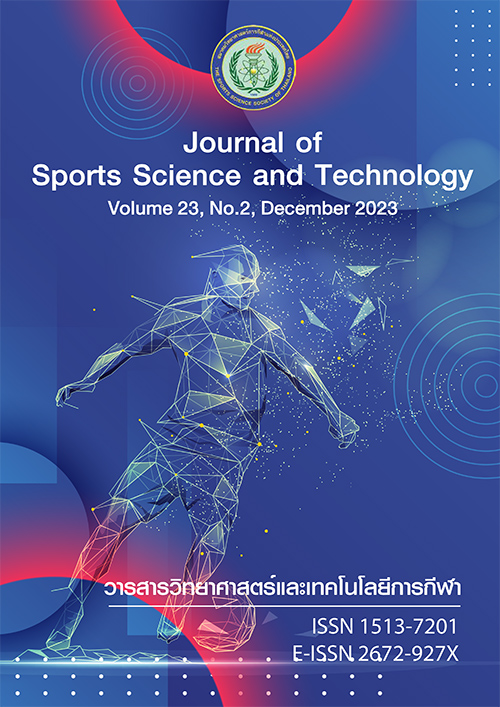THE EFFECT OF ELECTRIC HERBAL HOT PACK TREATMENT FOR DELAYED ONSET MUSCLE SORENESS AFTER EXERCISE TRAINING
Keywords:
Muscle soreness, Electric herbal hot compress pad, Physical fitnessAbstract
Intense exercise causes muscle damage. The most common symptoms such as pain, muscle tenderness, and swelling. As a result, the muscle strength and knee joint movement decrease. The pain also inhibits muscle recovery, which is the main cause of reducing exercise performance and has a psychological impact. Treatment of muscle damage after exercise is essential and effective therapy should be selected. The objectives were to develop and study the effects of electric herbal hot pack treatment for delayed onset muscle soreness after exercise training. Twelve volunteer healthy are Nakhon Phnom University students, aged 18.92±0.52 years, with a height of 166.42±8.22 cm. a weight of 66.50±12.88 kg and a body mass index (BMI) of 22.94±3.19 kg/m2 took part in this study. The perceived muscle soreness, leg muscle strength, and degree of knee joint movement were measured immediately at the baseline, and after intense exercise 30 min. Then treat muscle pain with electric herbal hot pack treatment, 24, 48, and 72 hours, assessing muscle soreness, leg muscle strength, and degree of knee joint movement. The results showed that after 30 min. intense exercise, perceived muscle soreness sensation increased, leg muscle strength, and degree of knee joint movement decreased were lower than before 30 min. intense exercise. When treating muscle pain with a electric herbal compress pad, it was found that perceived muscle soreness sensation decreased, leg muscle strength, and degree of knee joint movement increased after 24, 48, and 72 hours of treatment significantly (p<0.05). In conclusion, the electric herbal compress pad can relieve pain and reduce muscle inflammation.
(Journal of Sports Science and Technology 2023; 23(2):58-61)
(Received: 30 April 2023, Revised: 20 November 2023, Accepted: 27 November 2023)
*Corresponding author: Sakchai SRISUK
Department of Health and Sprot Science, Faculty of Education,
Mahasarakham University, Mahasarakham, THAILAND
E-mail: sakchai0072@hotmail.com
References
Clarkson PM, Hubal MJ. Exercise-induced muscle damage in humans. American Journal of Physical Medicine and Rehabilitation. 2002;81(11 Suppl), s52-69. Doi: 10.1097/00002060-200211001-00007.
Kim J, Lee J. A review of nutritional intervention on delayed onset muscle soreness. Part I. Journal of Exercise Rehabilitation. 2014;10(6), 349-356.
McHugh MP, Connolly DAJ, Eston RG, Gleim GW. Exercise-induced muscle damage and potential mechanisms for the repeated bout effect. Sports Medicine. 1999;27(3), 157-170. Doi: 10.2165/00007256-199927030-00002.
Morgan DL, Allen DG. Early events in stretch-induced muscle damage. Journal of Applied Physiology. 1999;87(6), 2007-2015. Doi: 10.1152/jappl.1999.87.6.2007.
Warren GL, Ingalls CP, Lowe DA. Excitation-Contraction Uncoupling: Major Role in Contraction-induced Muscle Injury. Exercise and Sport Sciences Reviews. 2001;29(2), 82-87. Doi: 10.1097/00003677-200104000-00008.
Connolly DAJ, Sayers SP, McHugh MP. Treatment and prevention of delayed onset muscle soreness. Journal of Strength and Conditioning Research. 2003;17(1), 197-208.
MacIntyre DL, Reid W, McKenzie DC. Delayed muscle soreness. The inflammatory response to muscle injury and its clinical implications. Sports Medicine. 1995;20(1), 24-40. Doi: 10.2165/00007256-199520010-00003.
Miles MP, Clarkson PM. Exercise-induced muscle pain, soreness, and cramps. Journal of Sprots Medicine and Physical Fitness. 1994;34(3), 203-216.
Chen TC, Nosaka K, Tu JH. Changes in running economy following downhill running. Journal of Sports Sciences. 2007;25(1), 55-63. Doi: 10.1080/02640410600718228.
McKune AJ, Semple SJ, Peters-Futre EM. Acute exercise-induced muscle injury. Biology of Sport. 2012; 29(1), 3-10. Doi: 10.5604/20831862.978976.
Serinken MA, Gencoglu C, Kayatekin BM. The effect eccentric exercise induced delayed onset muscle soreness on positioning sense and shooting percentage in wheelchair basketball players. Balkan Medical Journal. 2013;30(4), 382-386. Doi: 10.5152/balkkanmedj.2013.007.
Namsawang J, Rattanathongkom S. The comparison on physiological responses in skin temperature, blood pressure and heart between application of heated rice grain and traditional Thai hot pack. Journal of Medical Technology and Physical Therapy.2551;20(2), 148-155.
Kittamanorote J, Thamkom S. Development of Herbal hot Pack for Patients with Musculoskeletal System Disorders. Journal of Thai Traditional & Alternative Medicine. 2551;6(1), 18-23.
HardyM, Woodall W. Therapeutic effects of heat, cold, and stretch on connective tissue. Journal of Hand Therapy. 1998;11(2), 148-156. Doi: 10.1016/s0894-1130(98)80013-6.
Bleakley CM, Costello JT. Do thermal agents affect range of movement and mechanical properties in soft tissues? A systematic review. Archives of Physical Medicine and Rehabilitation.2013; 94(1), 149-163. Doi: 10.1016/j.apmr.2012.07.023.
Petrofsky JS, Lawson D, Suh HJ, Rossi C, Zapata K, Broadwell E, Littleton L. The influence of local versus global heat on the healing of chronic wounds in patients with diabetes. Diabetes technology and Therapeutics. 2007;9(6), 535-544. Doi: 10.1089/dia.2007.0231.
Parasin N, Kumfu S, Tummachai A. A comparative Study of Thai Herbal Hot Pack and Hot Pack in Pain Treatment of Low Backk Pain: A Randomized Controlled Trial. Srinagarind Medicine Journal. 2560;32(4), 372-378.
Loupattaraasem W, Kowsuwon W, Laupattarakasem P, Eungpinitpong W. Efficacy of Zingiber cassumunar ROXB. (Plygesal) in the Treatment of Ankle sprain. Srinagarind Medical Journal. 2536; 8(3), 159-164.
Manimmanakorn N, Manimmanakorn A, Boobphachart D, Thuwakum W, Laupattarakasem W, Hamlin MJ. Effect of Plai cream [Zingiber montanum (J.Koenig) Link ex A.Dietr. syn.ZingibercassumunarRoxb.] combined with ultrasound on delayed onset muscle soreness. Indian Journal of Traditional Knowledge. 2017;16(3), 442-447.
Szymanski DJ. Recommendations for the Avoidance of Delayed-Onset Muscle Soreness. Strength and Conditioning Journal. 2001;23(4), 7-13.
CrenshawAG, Thornell LE, Friden J. Intramuscular pressure, Torque and Swelling for the Exercise-induced Sore Vastus Lateralis Muscle. Acta Physiologica Scandinavica. 1994;152(3), 265-277.
Masuda T,Jitoe A. Antioxidative and anti-inflammatory compounds from tropical ginger: Isolation, structure determination and activities of cassumunins A, B, and C, new complex curcuminoids from zingiber cassumunar. Journal of Agricultural and Food Chemistry. 1994; 42(9), 1850-1856. Dio: 10.1021/jf00045a004.
Nakhostin-Roohi B, Nasirvand MA, Mahmoodi HS, Ghanivand B. The effect of curcumin supplementation on selected markers of delayed onset muscle soreness (DOMS). Annals of Applied Sport Science. 2016; 4(2), 25-31. Doi: 10.18869/acadpub.aassjournal.4.2.25.
Leung MS, Cheing GL. Effects of deep and superficial heating in the management of frozen shoulder. Journal of Rehabilitation Medicine. 2008;40(2), 145-150. Doi: 10.2340/16501977-0146.
Nadler SF, Weingand K, Kruse R. The Physiologic Basis and Clinical Applications of Cryotherapy and Thermotherapy for the Pain Practitioner. Pain Physician. 2004; 7(3), 395-399.






